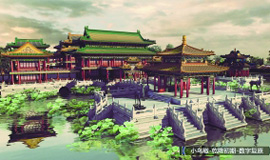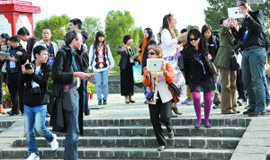|
 |
 |
|
BEYOND IMAGINATION: A 3D model of a corner of Yuanmingyuan during the reign of Emperor Qianlong (1736-1795) (BEIJING DAILY) |
AUGMENTED REALITY: Visitors experience the 3D version of Yuanmingyuan with mobile devices in the park (BEIJING DAILY) |
A mobile application promises to turn mobile devices into literal windows into China's imperial past. "Re-relic Yuanmingyuan" is a mobile app available for iOS and Android promising to take users back in time to view the Old Summer Palace as it once was, in three dimensions.
Yuanmingyuan, once known as the "Garden of Gardens" and "Versailles of the East," was an imperial garden built and repeatedly expanded under the personal supervision of five emperors of the Qing Dynasty (1644-1911). Construction began on the palace in the early 18th century in northwest Beijing. Unfortunately, it was looted, burned and reduced to ruins by Anglo-French allied forces in October 1860.
Debate continues over whether the ruins of Yuanmingyuan should be maintained as they are or the palace reconstructed as it was. Guo Daiheng, a professor with the School of Architecuture at China's prestigious Tsinghua University, says the ruins should be protected. "The park itself is an artifact with historical value; any change will reduce its authenticity," Guo said.
Research into the history of the site began long before embarking on the digital reconstruction project in 2009.
"We had researched it for 10 years and the historical materials at hand were enough to support the project," Guo noted.
The 3D models strictly follow historical records. The project, led by Guo, dynamically reconstructs Yuanmingyuan at different historical intervals reflecting different emperors' aesthetic and architectural preferences. Engineers painstakingly constructed 3D models for each architectural object.
"What makes the job difficult is the huge amount of data. The previous computer system couldn't possibly deal with it," said He Yan, a core member of the project and deputy director of the Architecture and Heritage Section of the Beijing Tsinghua Tongheng Urban Planing and Design Institute.
To create a data platform with sufficiently large loading capability, Tongheng's Digital City Section cooperated with Guo's team by offering a 3D geographic information system called "CityMaker." In order to make multiple-use models with high accuracy, technicians also need to grasp knowledge of ancient buildings.
"Among many domestic researchers on Yuanmingyuan, we have devoted ourselves to the work with great respect to history and science," Guo said. In the past four years, Guo and her colleagues have drawn 4,000 blueprints and made several thousand models. Each staff member worked 14 hours per day on average in the first one-and-a-half years.
By the end of 2012, they had completed 3D models of 35 virtual scenic areas, telling its stories of change from 1740 to 2012.
"People are curious about a destroyed cultural heritage. We just use a digital approach to help them perceive what it looked like before it was ruined and how it was changing," Guo said.
(Source: Beijing Daily) | 